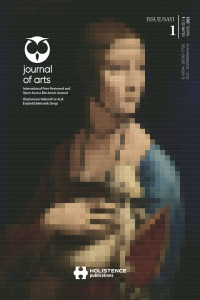Öz
Art undertakes the task of a cultural element that connects the artist to society. While the work created by the artist is a part of society, it also shapes the social culture with the effect of the changing understanding of art in the historical process. The aim of this research is to understand art, society, and artist relations by systematically evaluating art from a historical perspective; is to obtain data on the future projection of art. Artworks, which are the subject of evaluation and contain concrete retrospective information, provide information about how art will be in the future. In this context, first, the effect of the technological change experienced at the beginning of the 20th century on modern art was investigated. In addition, information is given about the relationship of art with social changes in the 20th century, with analyzes made on artists such as Monet, who opened the door for the interpretability of the work of art, Matisse, who expressed art as a way of life, Cezanne, who was under the influence of mechanization, and Picasso, who interpreted social problems. In the continuation of the article, with the emergence of the concept of abstract art, the transformation of art and the artist in the 20th century is discussed through Miro and Marcel Duchamp. With this transformation, the work of art breaking away from objective ties and focusing on the idea, and its conceptualization, gives information about how the art of the 21st century will be. In line with the systematic evaluations, it is seen that art and artists, under the influence of multiculturalism and globalization brought about by digitalization, are/will be in constant transformation. Thus, it is concluded that accessibility to art will become easier, interest in new geographies will increase, and art will continue to exist in new forms, independently of the artist, by becoming anonymized and reflecting society and culture in the future.
Kaynakça
- AKTULUM, K. (2016). Resimsel Alıntı (Resimlerarası Etkileşimler ve Aktarımlar). Konya. Çizgi Kitabevi. syf:78
- ANTMEN, A. (2008). 20. Yüzyıl Batı Sanatında Akım lar. 1. Baskı. İstanbul. Sel Yayıncılık syf:45-18
- ELMAS, H. (2006). Ondokuzuncu Yüzyıldan Günümüze Özgürlük bağlamında Sanat Neydi, Ne Oldu? Selçuk Üniversitesi Sosyal Bilimler Enstitüsü Dergisi, (15), syf:281-298.
- ERINÇ ,S.(1995). Resmin Eleştirisi Üzerine, Hill Yayınları, İstanbul, 1995.syf:53
- KAHRAMAN, H.B. (2015). Bakmak Görmek BirDe Bilmek (Çağdaş Sanat Dünyasında Hayatta Kalma Kılavuzu). 1.Baskı. İstanbul. Kapı Yayınları, syf:57
- THOMAS, H. (1995) Modernity and Culture Paperback Yayınları, US, 1995.syf:23
Öz
Sanat, sanatçıyı topluma bağlayan kültürel bir öğe görevini üstlenmektedir. Sanatçının ortaya çıkardığı eser toplumun bir parçası olmakla birlikte tarihsel süreçte değişen sanat anlayışının etkisiyle toplumsal kültürü de şekillendirmektedir. Bu araştırmanın amacı sanatı tarihsel bakış açısıyla sistematik olarak değerlendirerek sanat, toplum ve sanatçı ilişkilerini anlamak; sanatın gelecek projeksiyonuna dair veriler elde etmektir. Değerlendirm-eye konu olan ve geriye dönük somut bilgiler içeren sanat eserleri sanatın gelecekte nasıl olacağı hakkında bil-gi vermektedir. Bu bağlamda öncelikle 20. yy başında yaşanan teknolojik değişimin modern sanata olan etkisi araştırılmıştır. Buna ek olarak sanat eserinin yorumlanbilirliği için kapı açan Monet, sanatı bir yaşam biçimi olarak ifade eden Matisse, makineleşme etkisinde kalan Cezanne, toplumsal sorunları yorumlayan Picasso gibi sanatçılar üzerinden yapılan incelemeler ile 20. yy’da sanatın toplumsal değişimler ile ilişkisi hakkında bilgiler verilmekte-dir. Makalenin devamında soyut sanat kavramının ortaya çıkması ile birlikte Miro ve Marcel Duchamp üzerinden 20. yy’da sanat ve sanatçının dönüşümü ele alınmıştır. Bu dönüşüm ile birlikte sanat eserinin nesnel bağlardan koparak fikir üzerine yoğunlaşması, kavramsallaşması, 21. yy sanatının nasıl olacağı hakkında bilgiler vermekte-dir. Yapılan sistematik değerlendirmeler doğrultusunda, dijitalleşmenin bereberinde getirdiği çok kültürlülük ve küreselleşmenin etkisi altında kalan sanatın ve sanatçının sürekli bir dönüşüm içinde olduğu/olacağı görülmekte-dir. Böylece sanata erişilebilirliğin daha da kolaylaşacağı, yeni coğrafyalara olan ilginin artacağı, sanatın gelecekte sanatçıdan bağımsız olarak, anonimleşerek, toplumu ve kültürü yansıtan bir öğe olarak yeni formlarda varlığını sürdüreceği sonuçlarına ulaşılmaktadır.
Anahtar Kelimeler
Kaynakça
- AKTULUM, K. (2016). Resimsel Alıntı (Resimlerarası Etkileşimler ve Aktarımlar). Konya. Çizgi Kitabevi. syf:78
- ANTMEN, A. (2008). 20. Yüzyıl Batı Sanatında Akım lar. 1. Baskı. İstanbul. Sel Yayıncılık syf:45-18
- ELMAS, H. (2006). Ondokuzuncu Yüzyıldan Günümüze Özgürlük bağlamında Sanat Neydi, Ne Oldu? Selçuk Üniversitesi Sosyal Bilimler Enstitüsü Dergisi, (15), syf:281-298.
- ERINÇ ,S.(1995). Resmin Eleştirisi Üzerine, Hill Yayınları, İstanbul, 1995.syf:53
- KAHRAMAN, H.B. (2015). Bakmak Görmek BirDe Bilmek (Çağdaş Sanat Dünyasında Hayatta Kalma Kılavuzu). 1.Baskı. İstanbul. Kapı Yayınları, syf:57
- THOMAS, H. (1995) Modernity and Culture Paperback Yayınları, US, 1995.syf:23
Ayrıntılar
| Birincil Dil | Türkçe |
|---|---|
| Bölüm | Araştırma Makalesi |
| Yazarlar | |
| Yayımlanma Tarihi | 5 Şubat 2023 |
| Yayımlandığı Sayı | Yıl 2023 Cilt: 6 Sayı: 1 |

